| |
"'The Right Stuff' is an adventure film, a special effects film, a social commentary and a satire. That the writer-director, Philip Kaufman, is able to get so much into a little more than three hours is impressive. That he also has organized this material into one of the best recent American movies is astonishing." |
| |
Roger Ebert's 2nd review of The Right Stuff |
If this site has a unique distinctiveness well apart from the multitudinous waves of movie criticism you can surf, it is that we inject a personal perspective that needs to be missing from academia and any objective magazine coverage. This makes the site a very special pleasure to write for, unbound are we by commercial considerations. We champion what we like, how we like. We are strongly encouraged to present our own very personal take on the movie of choice. Well, The Right Stuff pushes a very special button of mine. It was the first movie I ever worked on. If – and I don't blame you – you've come for reasons to buy this Blu-ray, like now, then please skip to the next quotation and beyond that you'll find my review of a once unsung movie that has become a true American classic.

But if you can stand it, let me tell you what happened to a young man in 1982 who had bought a ticket to California and a return ticket from New York. This forced my hand. There was no magic button to press in San Francisco to go home and 'est' (see my review of Invasion of the Body Snatchers) had eaten up my 'get across country' money. I owed my friends for telephone bills and was not (and hope that I'm still not) someone who runs away from a debt. But I was literally down to my last single dollars. I had tried to get a job as an extra on a film shooting in San Francisco but was escorted from the production offices having been told that even the lowliest of the low, the runners, were paying to work on the film. Get that? Imagine the allure of any other industry getting you to pay for work experience. There's something profoundly attractive about filmmaking but alas most people who've not done it and get a practical taste soon understand that it's very early mornings, late nights, grueling on-your-feet days and unless you're above the line, it's not too well paid.
Well, desperation is a first class motivator so with enough money to buy an inconsequential breakfast on the go, I walked for two hours to the same 3rd Street production offices from which I was ejected a few weeks earlier and this time opened another door. A tanned, handsome, six-foot man, Dale, sat at the head of the room and two attractive, younger women sat at their own desks. They were all on the phone recruiting extras for the movie and having a small problem. The only African Americans at the historical event the movie was recreating were serving food and drink. Ah. This was Texas in the early 60s and the movie had to be 'true' to life. Well imagine what it was like getting phone calls non-stop all day from people and having to say that dreaded 'c' word... Caucasian. The movie's historically but not politically correct promotion for extras even made the TV news. Someone had got the wrong end of the stick and accused the production company of racism – Caucasians only. I can see how that bristled (and this was the year a short Yorkshire man was presented to the world in the role of Gandhi – OK, he had some Indian DNA but still...) The fuss soon died down. As I walked in, Dale handed me a piece of paper and motioned at a ringing phone. To my credit, I picked it up, said "Yes, this was the right number..." spieled my spiel from the page, was congratulated for my lovely accent and that was it. About fifteen minutes later, the bona fide applicant for the job walked in and without missing a beat, Dale employed her too. Welcome to the film industry. Up until that point on specific occasions in my life, I'd been happier but could count those moments on the thumbs of one hand. One morning doing the job, Dale just casually mentioned, "You know your country's at war, do you?" Thatcher had declared hostilities towards Argentina on my 21st birthday – thanks for the extra milestone, ding-dong...

I was kept on as a 'hired car' budget-wise and had weeks of gathering the crowd on the phone and then a few days orchestrating the extras in San Francisco's Cow Palace doubling up for the Houston Coliseum. Again, the accent came in handy and often I was passed a bullhorn to marshal the crowd. The extras even had me sign a few copies of Wolfe's book, an aspect of being attached to fame and celebrity at which I was consistently and delightfully surprised. If you look at the movie carefully, you can see the 'full' Coliseum was a significantly empty Cow Palace – the extras were strategically moved depending on the shot but still the editors chose shots that gave away the illusion if you knew what you were looking for. Today of course, digital crowd placement is a routine visual effect, mundane even. It turns out that the man who hired me was also responsible for filling the stadium in which two boxers slugged it out in some obscure movie called Rocky. With no budget for thousands of extras, the filmmakers used no stock footage but ingeniously, draped giant tarpaulins over the empty seats and punctuated the cloth with a small number of extras smoking thereby giving the impression of full crowds. Dale Benson also served as location manager for another obscure boxing picture, Raging Bull.

After hours both cast and crew of The Right Stuff gathered in a famous bar in San Francisco, Tosca's. It was bought by a good friend of Phil Kaufman's, Jeannette Etheredge and was the place to be during the shoot's down time. I can remember being in a state of near-nirvana sharing social time with this bevy of talented souls and managed to talk to a few of my heroes along the way (Lance Henriksen was pissed off that he was significantly cut out of Close Encounters and Veronica Cartwright passed on some playful insights on Hitchcock from a young girl's perspective. She was of course Mitch's younger sister in The Birds). Fourteen years later, I was lucky enough to experience something similar to this off-hours bonding while directing a four part series in Africa with a small crew. For reasons such as great ensemble personal chemistry and pure fun, we chose to spend each and every evening of our free time in each other's company. I've never had a work experience like it since. Suffice to say, you never forget your first and The Right Stuff was a movie rite of passage for me and to those who made it possible I will be forever grateful.
| |
"And a lot of people had problems with that. Many of the astronauts wanted to be portrayed as completely infallible. I always felt that John Glenn could have been president if he'd had more Ed Harris in him. (laughs) More of that sort of self-mocking, hipster guy." |
| |
Director Philip Kaufman on mixing history and satire.
Venice Magazine January 2001 |
In December 2013, a small group of very well known films was accepted into the National Film Registry of the Library of Congress in the US. Like the Oscar, this is an honour that bestows a quasi-artistic immortality on the filmmakers and in some cases this belated recognition enables a director to feel somewhat vindicated after an unspectacular box office performance. On this annual list were Mary Poppins, Pulp Fiction (a surreal double bill) and a lesser-known work, The Right Stuff, a Philip Kaufman directed epic about the test pilots of the late forties and the astronauts of the fifties' and sixties' Mercury Program. Based on the terrific but dense Tom Wolfe best-seller, the movie took nine months to make, was based almost entirely in San Francisco and starred a cast that if you brought them together today for a movie with no script and no director, your budget would be in the hundreds of millions before you started on page one. Despite the media hoopla accompanying its release, for reasons best known to the movie gods, the movie failed in the US. Because one of the 'real' astronauts, John Glenn, was running for Vice President the year the movie was released Stateside, there was a strong sense in the public arena that The Right Stuff was a vehicle for Glenn and many including Tom Wolfe himself blamed this misapprehension for the film's poor box office performance. The film made $21 million domestic from a $19-$27 million budget plus prints and advertising. The $8 million variation in budget is based on research – the first figure is Kaufman's, the second is from the IMDb. Regardless of the question of $8 million here or there, the film was seen as a significant flop. I'm assuming no one was throwing themselves off buildings because over the years the movie must have made money abroad and must have turned a profit with TV, VHS and DVD sales. I mean it ran in Paris for a whole year. The fact it's with us on Blu-ray and is rightly hailed as a modern classic of US cinema after over thirty years should tell us a lot about the vagaries of public taste in the 80s. But then I'm biased. I invited myself to a press screening in London in 1984 and once it was over I turned to my girlfriend and asked her how long she thought the movie was. "An hour and forty, hour and fifty minutes?" I smiled. The Right Stuff effortlessly broke the three-hour barrier but was so entertaining, the time just (ahem) flew by.

Famous screenwriter William Goldman did the first drafts of the screenplay before Kaufman was attached. He reports in Adventures In The Screen Trade that he saw it as a chance to celebrate America, to get a battered giant back on its feet with the amazing story of the Mercury astronauts. Once Kaufman was on board, Goldman realized with foreboding that his director's passion lay with legendary pilot, Chuck Yeager, the very personification of the 'right stuff' and the one man left behind as rockets replaced jets as funding magnets. Yeager, the best of the best, wasn't academically qualified so wasn't even considered as astronaut material. Goldman didn't believe that you could make one movie about both Yeager's baton passing and the astronauts taking it up. Kaufman wrote the script himself and not only melded both aspects but made it seem whole as if one could not follow without the other. In fact, The Right Stuff is so well oiled, it's fit to swim the channel. There's not a dud scene in the entire running time and each progressive moment acts like a benevolent but powerful snare to hurl you into the next. Kaufman doesn't advertise his intelligence the way other directors display their indifference and contempt. He simply makes movies that reward re-viewing and make you smile at an audacious cut or a sly piece of subtext. I mean there is a running gag in the movie that is literally a running gag. If it weren't for the extraordinary Unbearable Lightness Of Being, I'd say The Right Stuff was his masterpiece – close, damn close. But then directors can have two masterpieces or is that abusing the English language?
The story covers a period of sixteen years, from 1947 to 1963. We start with Levon Helm's distinctive Texas twang introducing us to the "demon that lived in the air..." as we fly through clouds. A test pilot tries to control the plane but a massive cut from 1.33:1 black and white faux and real newsreel to a 1.85:1 Technicolor explosion tells us in no uncertain terms that death is a constant companion to those who risk all day after day. On page 34 of Tom Charity's excellent BFI Classic book on the movie, he incorrectly identifies the aspect ratio as 2.35:1. It's the only ball dropped in an otherwise excellent accompanying volume. Chuck Yeager is cock of the hoop at Edwards Air Base in the high desert of California. Arriving to push their own mettle to the limits and beyond are test pilots who have over a twenty percent chance of not coming home from work each time they take off. In a small plane called the X1, Yeager breaks the sound barrier, the starting pistol for ever more ambitious attempts to be the fastest man on the planet. In tandem, the US government is recruiting pilots to be 'spam in a can', astronauts in the new space programme to compete with the Russians. As another personal note, it makes me smile that the pilots of Jeff Tracy's Thunderbirds family were all named after five of the Mercury 7 and the smile widens as mine and my father's names were included in the line up. In 1961, Yuri Gagarin becomes the first man in space and the race is on. The Americans react as they had to during the cold war, throwing money at their German scientists to get a man up there as quickly as possible... There are no character arcs, no twist endings and if you really know your history, not many surprises. But still the film manages to delight, satirize as well as celebrate the uncool squares that were thrust forward as competitors in the space race. The Right Stuff has its cake, its original ingredients, an affair with the baker, a deluxe spa, and it still gets to eat the cake at the end of the manicure. In short, there has never been such a fine juggling act from an ostensibly Hollywood picture. The film can claim to be a satire, a drama, an action picture, a buddy movie, a comedy, a tragedy, several love stories (metaphorical and actual) and a spiritual treatise on the best of our humanity. The fact that some of these should cancel out others if included in the same movie is proof that not only is Philip Kaufman one of America's great auteurs (if I may be permitted to give an ounce of credence to the silly theory given the army it took to make this film), it proves that even Hollywood cinema can do anything if it has the ambition and a director with a personal, artistic sensibility, a point of view. If I had to name what was missing in modern Hollywood fare, it's a single and undeniable point of view. The only true mystery of The Right Stuff is why it didn't take off at the box office.

The really unsung holders of the mystical and revered 'right stuff' are of course the wives and they are given their moments to shine. In particular, there's Barbara Hershey as Glennis Yeager. Her speech at the burnt out Pancho's Bar in the desert is particularly revealing. She places the right stuff in the chintz laps of her fellow (what might be called) WAGs, a derogative term these days that blithely indicates feminine compliance and the pleasing of their bread winning muscle owners. This was nothing of the sort. This was the right stuff distilled in the suppression of the desire to scream in horror every time their partner walked out to go to work. I've always had a yen (is that the term?) for Hershey, an actress who could pull off 'ordinary' while still managing to look stunning but alas, she has opted to go the way of Hollywood facial-improvement. I'm sure her reasons were valid ones but there are few sights more beautiful than people comfortable in their own skin. It's a pity the film industry places so many demands on looking youthful. The astronauts' wives are a cohesive group, establishing their camaraderie and closeness much earlier than their competitive, macho husbands. Veronica Cartwright's use of the word 'asshole' is on the money and there is a quietly reserved and contained performance from Mary Jo Deschanel playing John Glenn's wife whose stutter sets her apart until the wives coalition closes ranks and suddenly she's protected by a fiercely focussed, feminine union.
In 1985, I was in a taxi travelling through London. I knew that Bill Conti's heroic score for the film nabbed the Best Score Oscar the year before. I also remember with great clarity that I was sworn not to talk about this to those I was going to meet. I had been invited by director Richard Franklin to sit in on the scoring session of the film we'd both worked on together. The great Jerry Goldsmith was wielding the baton and it took a while for me to figure out what was so 'wrong' about Conti's success. Well, it took the form of two parts. Firstly, apart from all the other music that peppered the movie (Holst's The Planets, lots of time-specific pop songs and even a cue from a previous Kaufman movie, White Dawn, a superlative score from Henry Mancini), Conti hadn't all that much to contribute in terms of actual amount of original score. I understand he was given very little time to work on the film so he based his main theme on Tchaikovsky's Violin Concerto and changed a few notes. This is not exactly news when it comes to film music and as a student of mine once remarked, there are only so many notes so composers are bound to overlap. I don't mind overlap. I do mind someone being feted for an adaptation of someone else's graft. But perhaps the Academy voters were not familiar with the Concerto? Secondly, there was one particular score Conti's work was in competition with – you are way ahead of me; a score by Jerry Goldsmith that the composer rather liked even if he did say so himself. If you've not heard of or seen the movie with score in context, I urge you to seek out Under Fire, Roger Spottiswood's story of a war photographer in the middle of the Nicaraguan revolution. The score is astonishing, a full cue from which appeared bizarrely in DJango Unchained.

Then there're the special effects; it's 1982. Star Wars and The Empire Strikes Back have rewritten the FX rulebook with motion control cameras. Kaufman wanted none of that and urged his FX collaborators to get down and dirty. With the exception of Glenn's orbit where motion control was used, almost all the other effects in the film (all cut very fast so you get no chance to examine them) are physical in-camera effects achieved by the most practical of means. You want a shot of a plane 'going upstairs' like a bat out of hell? Great! Tie the model to some helium balloons and pray you have camera operators who can see the damn thing in their viewfinders never mind keep it in focus. On the flip side of that, the FX guys threw models, some intricately built, out of windows to shoot them hurtling towards the camera. The inherent romanticism of shooting live FX as illustrated in the wonderful photos in Cinefex Issue No. 14 is a piece of history I will always cherish. The FX team got through a lot of models. Kaufman engaged independent filmmaker Jordan Belson to create air-scapes, surreal moving images that gave the impression of a living sky. And while his imagery is spectacular (or was for its day) you must credit SFX guru Gary Gutierrez for doggedly pursuing what Kaufman was after despite many restarts and an intimate relationship with square number one.
The Right Stuff is that rare beast, a multi-genre epic that changes gear from one style to another with such grace and ease, you wonder why films have not been made since 1983 with similar thematic and genre fusions. How can a western sit prettily with a satire of the role of the press and government in pushing the US forward in the world's eye and ally that with hugely exciting action scenes of the planes and capsules in flight? The answer is, it just can and does so superbly. Kaufman had found a subject and thematic approach that suited his own sensibilities very well. Am already looking forward to the 4K 40th Anniversary...
My initial response to the transfer on this 30th Anniversary Blu-ray release was one of very slight disappointment – my rose-tinted memories of how crisp the image looked in the cinema on projected 35mm film had led me to expect a needle-sharp picture that popped from the screen, which is not quite what we get. What we have instead is an image that would best be described as rich rather than crisp – the detail is definitely there, but there is a very slight softness to elements of the picture when compared to HD transfers of more modern studio productions. However, you soon realise is part of the film's aesthetic, creating a convincing period feel without resorting to colour tinting and allowing a far better match with the incorporated NASA footage (you can see an example by clicking on the picture below for a full-sized frame grab), and in that respect benefits from not being artificially sharpened at the digital transfer stage. So while it may not drop jaws, this is still a really attractive and consistently well graded transfer that visibly improves on all previous DVD versions, particularly in the removal of remaining dust spots and other traces of damage, including the sizeable black scratch that used to blight the sideways track of the astronauts as they are introduced at the below-pictured press conference (if you want to get a taste how it looked before this clean-up, check out the selected scene commentary on the Extras disc, which is peppered with small dots and still displays that aforementioned scratch). The film grain is fine and the contrast is well judged, important in a film in which characters are repeatedly shot with their faces in shadow. The colours are most attractively rendered and in daylight scenes are pleasingly naturalistic, something that has almost disappeared in the age of digital grading. There are also no sign of compression artefects or digital banding. Only one tiny gripe – the image is framed at the increasingly common 1.78:1 instead of the original 1.85:1. Otherwise, however, a very fine job.

click on the picture or this message for a full-sized grab
The Dolby TrueHD 5.1 surround soundtrack does well by the film's superb sound design, with clear reproduction of voices, sound effects and Bill Conti's score, and some serious bass wallop on explosions during the rocket testing sequence. The stereo separation is sometimes very distinct, and while the use of the surrounds is confined largely to the score, just occasionally a sound effect makes striking use of the full sound stage – at one point during Yeager's sound barrier attempt, the X-1 engine roars right past our heads.
With the exception of the letter and booklet, all of the extra features have been ported over from the US 20th Anniversary DVD release.
Realizing the Right Stuff (21' 06")
The first thing that hits you playing this documentary is that the filmmakers have gone to the trouble of securing the voice over talents of 'Ridley' from the movie and the original narrator played by Levon Helm. That voice simply legitimizes everything that follows. Repeat after me... "There was a demon that lived in the sky..." Let's also acknowledge his musical career being one of the original members of The Band. This is a straightforward talking heads/movie clips presentation of how the film came about with some lovely details along the way. Kaufman recalls cinematographer Caleb Deschanel leaping on the hood of a car that was messing up the desert sands and pounding his fists. "That's want you want, a cinematographer who'll risk his life for the look of a picture..." The recollections are entertaining with a special nod to the importance of the bar in San Francisco where cast and crew hung out after shooting. My own memories of that place are so powerful and so – dare I say – ecstatic that if the film had not turned out as great as it did, I wouldn't have minded one jot. The fact that I played a tiny part in the making of an American Classic is just a bonus beyond imagining.
T Minus 20 Years and Counting (11' 29")
"It was a nine month shoot and no one wanted it to be over..." So said actor Dennis Quaid who played Gordo Cooper. That's the holy grail of film production. When it came to exhibition and distribution, that's a different story. This is, to all intents and purposes the second part of the first Extra, a muse on the post production including the SFX, music and a general wrap up from the featured actors. Ed Harris mentions that the movie will be around for another twenty years (ten from our perspective). I have to say I agree with him.

The Real Men with the Right Stuff (15' 31")
As if you needed proof of the visual veracity of Kaufman's movie, here's the real thing. With fascinating behind the scenes of NASA's finest testing equipment and astronauts alike and interviews with the surviving Mercury Seven astronauts, this is a space junkie's mini-fix. The elderly Gordo Cooper is not the easiest to understand (he contracted Parkinson's Disease so in the last year of his life, he talks as if suffering from a stroke) but this is the most easily forgivable aspect in this essential little Extra. It is a constant surprise to me that the reality of the Mercury program (sic, US spelling) was so wonderfully realised by Kaufman and his amazing crew. Some of Kaufman's artistic licences are challenged by the guys who were actually there at the time but there's no sense at all from the astronauts themselves that there is any bad feeling that the 'truth and nothing but the truth' wasn't conveyed. They all seem to understand that storytelling is not truth telling. Gus Grissom's hatch-blowing mishap is presented in an extenuating light and the real Chuck Yeager is on hand with gems like this... "There's no emotionalism involved. You got a job to do. You get killed, that's the way it goes." Wow.
The Journey and The Mission Audio Commentary with Selected Scenes (24' 29" x 2)
A bit of a teaser this, providing as it does two audio commentaries – one by the cast, the other by the filmmakers – but over selected scenes only and running for only 24 minutes of the film's 193 minute run time. Structured in the manner of Criterion commentaries, with each of the participants recorded individually and their comments then edited together, both tracks are engaging enough to make you wish that they ran for the whole of the film.
The Cast includes contributions from Dennis Quaid, Barbara Hershey, Jeff Goldblum, Harry Shearer, Fred Ward, Ed Harris, David Clennon, Veronica Cartwright, Pamela Reed and Donald Moffat. Consisting largely of memories of working with each other, researching their roles and the shoot itself, it's an engaging rather than substantial track, the best bit of which comes right at the start with a contribution from Chuck Yeager himself (he does have a cameo so is technically a cast member), who lends the film some serious credibility by stating "Whoever cast that film did an outstanding job."

Discussing the same scenes are The Filmmakers, specifically writer-director Kaufman, cinematographer Caleb Deschanel, composer Bill Conti, visual effects supervisor Gary Gutierrez and producers Robert Chartoff and Irwin Winkler. For my money this is a more informative track that delivers plenty of background detail on the production and technical aspects of bringing it to the screen. Caleb Deschanel reveals how some scenes were lit, Bill Conti talks about recording sound effects and having only three weeks to write the score, the producers discuss casting key roles and the importance of the wives to the story, and Kaufman confirms that for him Chuck Yeager was the essence of the book. I particularly liked Winkler's amazement at getting the then unknown Ed Harris: "We couldn't believe that John Glen incarnate could be available to us."
Additional Scenes (10' 54")
A number of cut shots, short sequences and alternative takes. They're all of interest but none add anything to what the film already does perfectly in its present form. One sequence in which Gordo attempts to explain to Gus how he should sell himself to Nurse Murch – which is then visually realised with a ghostly Gordo in frame offering advice to his friend – is one I'm really happy Kaufman chose to discard.
Interactive Timeline to Space
A list of some of the key events in America's space program that when individually clicked on play news footage relating to the story in question, each narrated by Levon Helm.
John Glenn: American Hero (96' 31")
A feature-length documentary portrait of John Glenn made for PBS television that covers Glenn's life and career in some detail. There's some hero worship in patriotic music, the stirring narration and religious reverence, but there's still some fine stuff here, particularly in the archive footage of the astronauts at work and at play. Those interviewed include fellow Mercury astronaut Scott Carpenter, Glenn's biographer Frank van Riper and Glenn himself, and the film covers his later career in politics, the 1992 savings and loan scandal and his desire to go back into space, the preparations for and execution of which occupy the final two-thirds of the film.
Theatrical Trailer (3' 33")
There are some spoilers for the historically unaware in this rather neatly assembled sell for the film.
A genuinely great work of late twentieth century American cinema and one of those rare films that gets just everything right. An object lesson in whip-smart and seductive character-driven storytelling, it's gorgeously structured and directed and is immaculately performed by a top-flight cast, many of whom were at the dawn of their film careers here. Warner's 30th Anniversary Blu-ray recycles its extras from its own earlier DVD release, but the picture quality bump still makes this the one to go for, and with no regional coding (hoorah!) it's also playable on region locked UK Blu-ray machines. Highly recommended. |